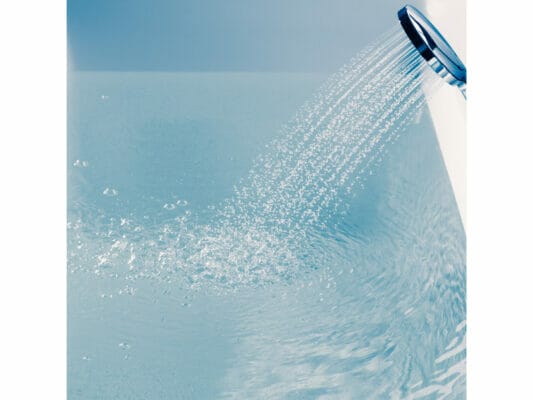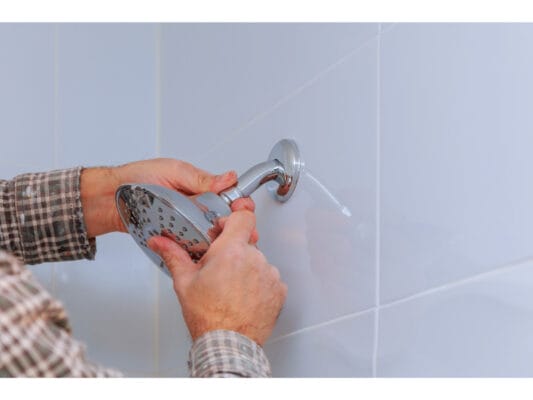Disclaimer: This post may contain affiliate links, meaning we get a small commission if you make a purchase through our links, at no cost to you. For more information, please visit our Disclaimer Page.
When the diverter turns inside, it allows water to flow either to the showerhead or bathtub, but build-up rusts or debris may make it not work as it should. Also, the diverter may undergo some wear and tear that makes it difficult for the diver to function properly.

Table of Contents
Is It Normal That Water Is Dripping From The Showerhead?
When water drizzles or drips from the showerhead, it is a tell-tale sign that the valve has a problem. The drip may result from worn-out parts or a clog because of hard water deposits or corrosion.
Also, you will see the dripping when the gaskets and O-rings that seal the connection and moving parts wear down.
Therefore, when you turn off the faucet, water will continue dripping from the showerhead. So naturally, you may want to crank the handle and try to close it as hard as it is possible. But this may only worsen the situation.
So, the moment you see water dripping from the showerhead but the faucet is turned off, do not try to overtighten it, since such action can only damage the valve.
Why Is Water Coming Out Of The Showerhead While Filling The Bathtub?
Sometimes you may notice that when you turn the faucet off, water will still fill the bathtub while dripping from the showerhead. But this is something you can easily fix once you identify the affected part and institute some form of repair.
Notice that the cause of the problem may not matter. What counts is that this is something you can fix on your own without the need to involve an expert.
But the most challenging part of the task is to find where the issue is before fixing it. However, since the problem is that water is coming out of the showerhead even when the valve is off, the next important thing you will need to do is to check the bathtub faucet.
If you notice that it still leaks even after you close the valve, consider replacing the valve.
You may also try to check the level of water pressure. If there is a difference in the pressure, it may point towards an installation mishap, which means that someone may have incorrectly installed the pipes.
It results in water pressure problems, and so you will need to contact a professional to help fix the issue.
If you do not have the funds, you can solve the issue by taking the faucet out and replacing it. Here is how you can fix the problem:
Use a screwdriver to remove the screws holding the faucet in place. But, before you remove the screw, try to use a putty knife or a sharp object to scrape the caulk between the wall and the faucet. It may be hard for you to see the screw if they are under the faucet, so you’ll need to use a spotlight to see the screws.
But if the faucet is the slip-on type, all you need to do is pull it off the wall. You can do this by turning it counter clockwise before removing it from the wall.
Once you remove the faucet, you may want to turn the water on to see if it comes out of the shower. If water does, know that the issue is not with the spout. So, it may necessitate that you check the spout for blockages.
If you see a clog, use tweezers or any sharp object to remove it. But if you find it difficult to remove the blockage, consider buying a new faucet.
Also, the issue may be with the diverter valve. This is the lever you pull to direct water to the showerhead. But it may be difficult to fix or repair the valve. So, the option you have is to buy another valve.
If the cause of water leaking while filling the tub results from mineral and dirt build-up, you must try to remove the build-up.
You can do this by placing the head in the vinegar for some time. But if you choose to use some other chemical remover, follow the guidelines on how to use it to remove the build-up.

How To Fix Water Dripping From The Showerhead?
The rhythmic drip-drip from your showerhead is annoying and can make it difficult for you to sleep soundly. It also wastes gallons of water and is likely to increase your water bill.
So, the best thing you should do is to fix the problem before it gets out of hand. It removes the nuisance and will help you save on water bills.
But you have several methods to use to fix the leaks. Fixing the showerhead is one of them, however, it may not stop the leak. But this is where the process of fixing a leak should start. After which, you need to check if some sediments and blockages may be causing the dripping.
But first, stop the flow by shutting it at the main control. You can then turn and remove the showerhead. You should then proceed to remove the showerhead.
You may use a damp towel to turn the showerhead. But if you feel that it is too tight, try to use a wrench.
Cleaning the showerhead– ensures that you clean the showerhead and remove all the dirt. You may do this by submerging it in vinegar for about two hours. After the lapse of the two hours, ensure to rinse it in cold water.
Wrapping the threads – wrap a thread with an appropriate water sealant tape. Use Teflon tape since it will give you the best results. Also, ensure to wrap the sealant in the thread’s direction.
Replace the showerhead onto the pipe extension and ensure to tighten it using your hand. You may briefly turn the water on and off to monitor if the leak is still persisting.
Replacing the faucet cartridge – ensure to replace the cartridge because it will be responsible for regulating water flow.
But if your cartridge does not seal tightly, you will notice some water trickling down. So, remove and tighten it until when the leak stops. But if the leak persists after the second attempt, proceed to change the cartridge. Here is the procedure:
Shut off the water at the controls – If your home has an intermediate shut-off valve, you may access and shut it off before you start working. However, if you cannot trace it, shut it off at the main.
Unfortunately, when you shut off the water at the shower control, it may cause flooding, extending behind the shower walls. You can proceed to remove the handle. You may also need to unscrew the handle with an appropriate screwdriver. In some instances, it may require that you use the Allen wrench to help in removing the handle.
Removing the retaining clip- you will need to remove the cartridge retaining clip using a blunt knife or a screwdriver. Slide the old cartridge out from the control without turning or twisting it. You can loosen your cartridge from the control with pliers.
Install a new cartridge- slide a new cartridge into the controls and ensure it is properly aligned before you twist back the retaining clip in its place.
Replace the control- finally, you will need to replace the handle and turn the water on. Again, monitor your showerhead for possible leaks.
Conclusion
You should not panic when you notice that water is coming from the showerhead while filling the bathtub since this is a problem you can easily fix.
Firstly, consider cleaning the diverter. If it is clogged, remove the clog and see if it works. If it does not give the desired results, consider replacing it with a new one.
